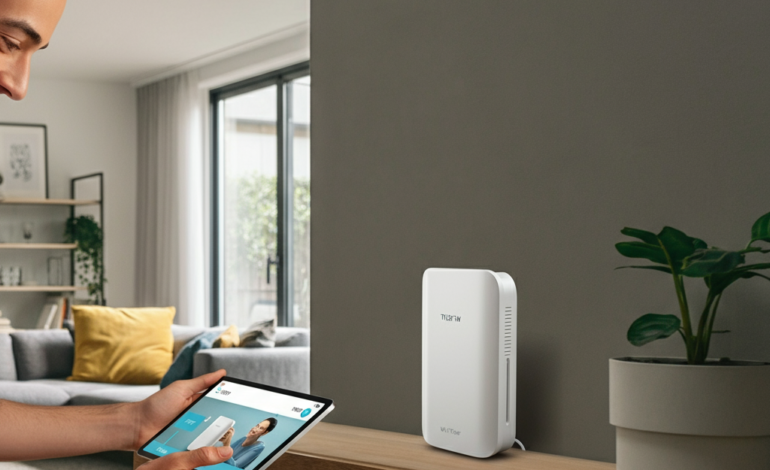How to Connect a Wi-Fi Repeater for Seamless Home Networking

Wi-Fi connectivity is a necessity in today’s digital age. From streaming to online meetings, we all rely on a strong connection. If you’re facing dead zones, learning how to connect a Wi-Fi repeater can help extend your network and ensure seamless coverage throughout your home, eliminating interruptions and improving overall performance.
A Wi-Fi repeater offers an effective, affordable way to expand your home network coverage. Whether you’re a tech expert or setting one up for the first time, this guide walks you through the connection process, placement tips, troubleshooting strategies, and insights into their role in modern networking.
What Is a Wi-Fi Repeater and Why Do You Need One?
A Wi-Fi repeater, sometimes called a range extender, is a device that boosts your existing Wi-Fi signal to cover areas with poor or no connectivity. Whether you live in a home with multiple floors, thick walls, or extensive outdoor areas, a repeater can eliminate dead zones, providing seamless connectivity.
Cynthia Lee, a network infrastructure specialist, explains the importance of Wi-Fi repeaters in today’s home setups, saying, “With households running multiple devices on a single network, Wi-Fi repeaters play a crucial role in maintaining performance and accessibility across all areas of the home.” To enhance your home network further, you might also consider using the best Ethernet cable for gaming, which can provide a more stable and faster connection for your devices.”
How Do Wi-Fi Repeaters Work?
Wi-Fi repeaters work by capturing your router’s existing signal and rebroadcasting it to areas with poor connectivity. Here’s how it functions in simple terms:
- Receive the signal: The repeater connects wirelessly to your primary router.
- Boost and transmit: It amplifies the signal and retransmits it to cover a wider area.
This process enables your devices to stay connected without sacrificing internet speed or bandwidth. Many modern repeaters come with technologies like dual-band operation, allowing them to broadcast on both 2.4GHz and 5GHz frequencies.
Step-by-Step Guide to Connecting a Wi-Fi Repeater
Setting up a Wi-Fi repeater is easier than you might think. Here is a step-by-step guide to help you get started:
Step 1: Choose the Right Repeater
Before you begin, ensure your repeater is compatible with your router. Check for features like dual-band support, range capacity, and WPS compatibility.
Step 2: Locate the Optimal Position
Place your repeater halfway between your router and the area with weak Wi-Fi. This ensures it receives a strong signal to effectively rebroadcast.
Step 3: Plug in the Repeater
Connect your repeater to a power outlet. Most devices have a signal indicator LED to show if they’re receiving a strong connection.
Step 4: Connect the Repeater to Your Network
- Using the WPS Method (if supported): Press the WPS button on your router, followed by the one on your repeater. The devices will automatically link.
- Manual Setup: Connect to the repeater’s temporary network via a computer or smartphone, then access its setup page by entering the given URL (e.g., 192.168.x.x) and follow the on-screen instructions.
Step 5: Configure Wi-Fi Settings
Name the repeater network, matching or differing from your router’s network SSID, depending on your preferences. Save your settings and restart the repeater.
Step 6: Test the Connection
Once set up, test the repeater by connecting your devices and checking for improved network performance in previously low-signal areas.
Understanding WPS and Its Role in Range Extender Setup
Wi-Fi Protected Setup (WPS) is a convenient feature that simplifies connecting devices to your network. Most modern repeaters support WPS, eliminating the need for manual configurations. When using this method:
- Press the WPS button on your router.
- Within two minutes, press the WPS button on your repeater.
- Wait for the indicator light to confirm the connection.
While WPS is user-friendly, manual setup is recommended if advanced network configurations or security changes are needed.
Placement Tips for Maximum Coverage
Finding the ideal location for your repeater significantly impacts its performance. Here are some quick tips:
- Stay within signal range: The repeater must be within your router’s signal area to rebroadcast effectively.
- Avoid interference: Keep the device away from obstructions like thick walls, microwaves, or electronic devices that can disrupt the signal.
- Experiment with placement: Most repeaters have LED indicators to help you find the best spot. Experiment with positioning until you achieve optimal coverage.
Ryan Smith, a tech reviewer, shares his experience, stating, “Placing my repeater on the upper floor, equidistant from the router and my office, gave me flawless Wi-Fi for work and streaming.”
Troubleshooting Common Wi-Fi Repeater Issues
Wi-Fi repeaters can occasionally run into problems. Here’s how to resolve the most common issues:
- Weak signal: Ensure proper placement and avoid obstructions. You may also move the repeater closer to the router.
- Intermittent connection: Update your repeater’s firmware to the latest version.
- Slow speeds: Check if too many devices are connected to the repeater. Disconnect unnecessary devices and test again.
- Failure to connect: Reset the repeater and retry the setup process, ensuring you follow the provided instructions.
Future of Home Networking and Wi-Fi Repeaters
With smart homes and IoT devices booming, seamless connectivity is more important than ever. Wi-Fi repeaters are evolving to keep up, incorporating features like mesh networking and smart home integration.
According to industry analyst Linda Chavez, “The next generation of Wi-Fi repeaters will emphasize intelligent signal routing and greater compatibility with mesh networks, making them indispensable for the modern home.”
Key Takeaways
A Wi-Fi repeater is an excellent investment for extending your home network, ensuring strong and reliable connectivity across every corner of your space. Here’s a quick recap of what you’ve learned:
- Wi-Fi repeaters eliminate dead zones by amplifying and rebroadcasting your router’s signal.
- Setup is simple, whether using the WPS method or manual configuration.
- Optimal placement and troubleshooting strategies are key to achieving maximum coverage.
- The future of Wi-Fi repeaters will bring even smarter, more efficient connectivity solutions.
Tell Us Your Experience
Have you tried a Wi-Fi repeater to improve your home network? Share your experience in the comments below or ask any questions—we’re here to help make your signal stronger!
Additional Resources
If you’re looking for more insights and tips, check out these resources:
- Top Wi-Fi Repeaters for 2024
- Understanding Dual-Band Wi-Fi
- How to Optimize Your Home NetworkMeta Data Meta title How to Connect a Wi-Fi Repeater Easily Meta description Learn how to connect a Wi-Fi repeater to extend coverage, improve setup, and eliminate dead zones with this step-by-step guide.
- Understanding Dual-Band Wi-Fi








1 Comment
[…] Disconnect or unpair any unused Bluetooth devices. For more ways to optimize your network and ensure a better connection, check out how to connect a Wi-Fi repeater. […]